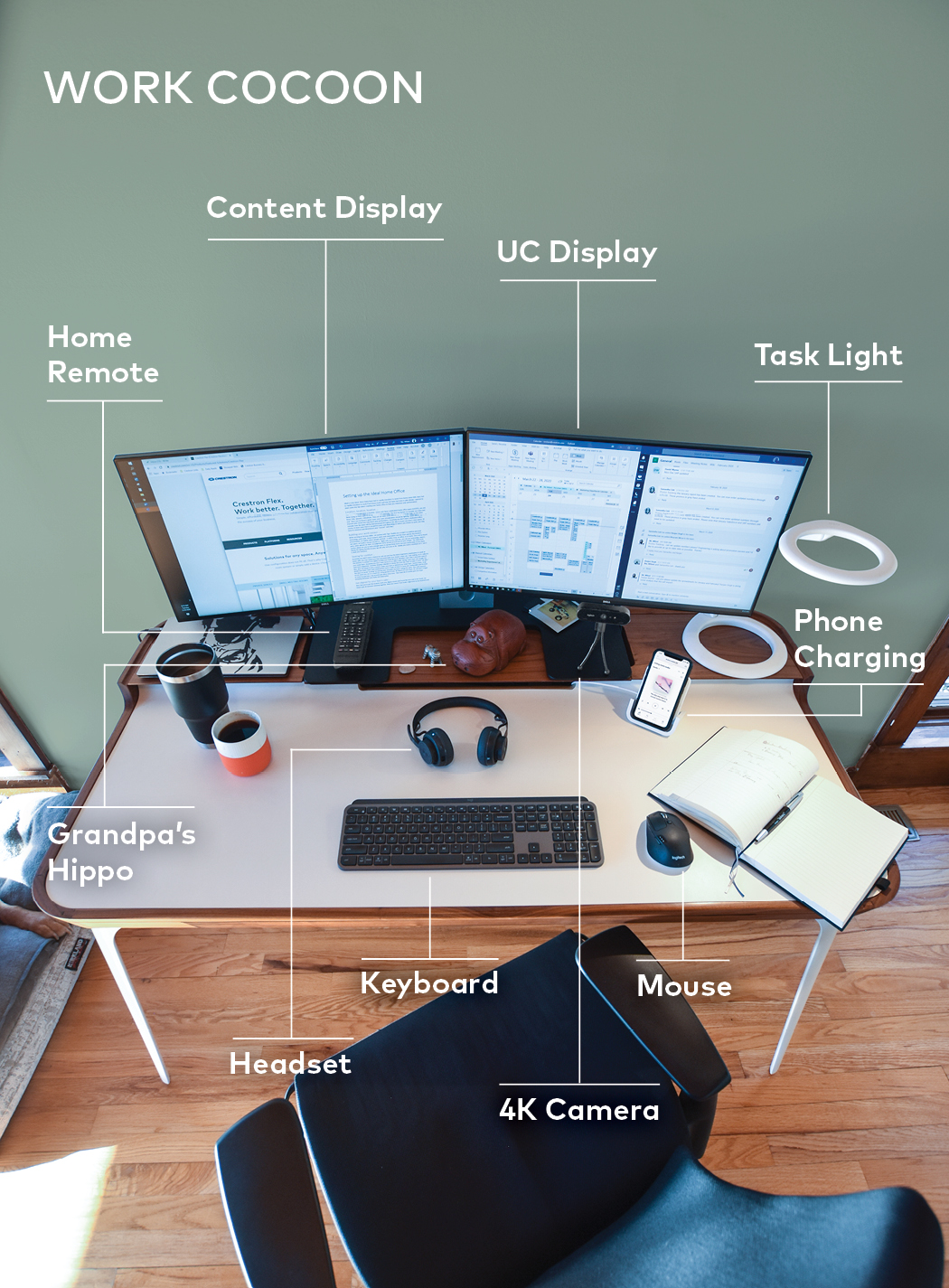Ideal is a key word. Since many have had to rapidly transition to work-from-home mode and may not have had time to plan ahead, I wanted to share some key tips when creating your home office to help you maximize your performance.
Location, location, location …
Unless you have a dedicated home-office space, you are likely trying to find a spot to co-opt during your workday. The first key factors to consider are noise and focus. Kids, partners and pets can disrupt you and co-workers on the other end of your call. Once you’ve found a quiet room, your next consideration should be lighting. Good natural light will improve your mood and help boost your performance. Assuming you don’t have a dedicated office, consider how the space will be dual purposed throughout the day to insure you aren’t interrupted. Of course, in most cases there is no perfect place and depending on where you choose to work, you may have to construct and deconstruct your “cocoon” each day. A final suggestion? Keep yourself the focus of attention on your video calls and eliminate background distractions by turning on background blur or images.
Building your work cocoon …
I once led a research project focused on mobile workers and technology. The team quickly discovered a phenomenon; no matter where people worked – a coffee shop, an office, or at home – people created a “personal cocoon” with their devices and content. Right now, as you read this, you can see technology, papers, pens, water glasses spread around you at arm’s length – that is your cocoon. The ideal work-surface allows you to have enough space to spread these items out and comfortably access them. Sitting the laptop literally on your lap will only carry you so far. Ideally you need a minimum of 3’, but 5’ is ideal and luxurious to insure you have access to all your content without breaking your flow. Now may be the time to consider a laptop stand. The angle of a laptop stand helps reduce neck strain. It also keeps laptops cooler and when placed on your countertop can give you the option of some “stand up” time. No stand? Try propping your laptop atop some books.
Seating for comfort …
Assuming you don’t have an office chair at home, you may realize just how uncomfortable your home’s chairs are. Task seating, as it’s called in the industry, is unique in its ability to keep your body forward, shoulders back (this is key) and support your lower back. Assuming you don’t have access to an office chair, dining room chairs are usually the next most supportive. Consider draping a blanket or sheep skin over the chair to make it more “sit-able.” Also, consider sitting on a cushion or placing one behind your lower back. Variety helps, so go ahead and rotate chairs and combinations every couple of hours to keep you comfortable and focused. The key is to avoid “turtling” or rocking your shoulders forward, curling the spine. This same posture occurs when you sit on a couch for a long period of time. You won’t realize it in the moment, but you may find, over time, you are complaining about aches and pains. It’s your posture.
Oh, and don’t forget to stand up and take a lap around your place every hour. That small bit of activity gets the heart pumping and keeps your body and mind active.
Get aligned for your back’s sake …
Now that you’ve got the location, built your cocoon and found the best seat in the house, we need to get all elements working together. What do I mean? Your body’s alignment to the keyboard will impact typing accuracy. Typing accuracy will impact cognitive performance. For the sake of discussion, let’s assume you can find a place to work, set up your cocoon and sit comfortably. Now we want to harmonize those elements. Knees bent at 90 with feet grounded; arms bent at 90 comfortably resting on the tabletop. That is ideal.
Technology for efficacy …
Finally, once you’ve got the basics, you can start to layer in key technologies to increase your effectiveness. In order of importance …
1. A mouse – ditch the trackpad, you are simply faster when using a standalone mouse. It’s a fact. My favorite? Logitech MX Pro and Microsoft Surface Arc Mouse.
2. Laptop stand–the angle of a laptop stand helps reduce eyestrain and neck strain. It keeps laptops cooler and when placed on your countertop can give you the option of some “stand up” time. No stand? Try propping your laptop atop some books.
3. A good audio device –The key is to get something that is designed to work with video conferencing equipment. A certified device will go a long way and will work WITH your application to insure you sound amazing and everyone hears you. Plus, it usually solves simple, yet important challenges, like muting.
4. Task lighting – Nothing fancy, but a good downlight by your desk will help you focus and insure you can read what you write on paper reducing eye strain and improving concentration.
5. External Monitors – Assuming you have them, they help you spread content and work faster. They can also help lift your head, reducing neck strain caused by looking down at a laptop display.
6. Wireless keyboard–speaking of laptops, wireless keyboard helps take the pressure off wrists.
7. Video Camera – A lot of laptops have a very awkward camera positioning. My laptop takes a specific up-the-nose shot that isn’t flattering and is often times more distracting than helpful. A good camera, positioned as close to eye level as possible and centered on where your virtual guests will appear, provides the best outcome. And, of course, no backlighting!
8. Phone stand – having your phone propped up helps you see alerts without forcing you to reach for the device. Again, keeping you in your peak cognitive zone.
9. Docking station – last but not least, this allows your laptop to travel with you without having to destroy your new virtual home every time you need to clear out of the space.
Balance, balance, balance …
Finally, as a person that has worked from home, large offices, small offices, coffee shops and hotels, you need to remember to balance your needs as a worker and as a human. Many folks reading this have had to create a home office from nothing. You may have limited space and will be forced to build your home office in a space that is meant for living (dining room, living room, bedroom, etc.). Think about the end of each workday or work week. Where does the technology go so you don’t have to see it, think about it or live with it? My office is in our bedroom. For that reason, I’ve given extra care to make sure it’s decluttered, clean and turned off at the end of my workday. If you’ve got your cocoon set up on the dining room table, perhaps as a family you agree to cover it with a black sheet at the end of the day and deconstruct each Friday for the weekend. It’s all about balancing your home and work, especially during a time period when you can’t leave, and everyone is under additional stress.

.jpg?width=650&height=882)